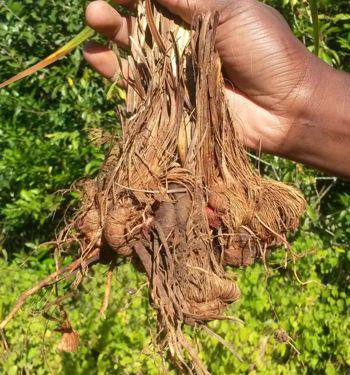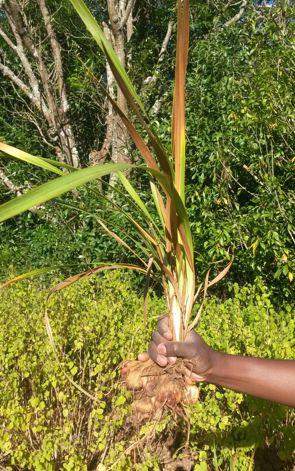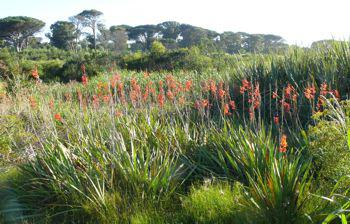Watsonia angusta
Watsonia angusta Ker Gawl.
Family: Iridaceae
Common names: red watsonia (Eng.); grootrooipypie, rooipypie (Afr.)
Introduction
This beautiful plant, with striking red flowers, grows from an underground corm. It has light green leaves shaped like a sword. The plant is useful for wet areas in the garden.

Description
Description
Watsonia angusta grows up to 2 m high. It has an underground, depressed globose corm 20–30 mm in diameter, with a coarsely reticulate, grey-brown tunic; sometimes several cormlets are found in the axil of the lower leaves. The stem is simple or usually with a few, short, diverging branches.

Leaves are 5 to several, more or less basal, but the uppermost of these sheath the stem, and are about half as long as the plant. They are narrowly lanceolate and sword-shaped; the margins are slightly to moderately thickened and hyaline. The leaves dry off and the plant is dormant during the dry season.

The inflorescence is a lax, up to 18-flowered spike. Flowers are red to orange; it has a long cylindric upper perianth tube with very narrow petals 4–8 mm wide, with a somewhat hooded upper tepal, reflexed lateral tepals and a strongly recurved lower tepal. The fruit is an up to 35 mm long, tapering, fusiform capsule, splitting open to release small, linear seeds. It flowers from November to January.
Conservation Status
Status
Watsonia angusta is assessed as Least Concern (LC) according to the Red List of South African plants.
Distribution and habitat
Distribution description
Watsonia angusta is found almost over the entire winter-rainfall areas of the Western Cape, extending from Piketberg to the Transkei in the Eastern Cape and Underberg District of KwaZulu-Natal in the summer-rainfall areas. It grows in more or less permanently wet places such as marshes and seeps, along stream banks and sometimes even in gently flowing streams.

Derivation of name and historical aspects
History
The name Watsonia honours the English professor of botany, Sir William Watson (1715–1787). The specific epithet, angusta is from the Latin and means ‘narrow perianth tube’. Watsonia angusta is based on an illustration published by Nicholas Jacquin in the Icones plantarum rariorum in 1796 under the name Gladioli meriani.
Ecology
Ecology
As the flower shape and colour of Watsonia angusta are similar to several species that are visited actively by sunbirds, this species may be pollinated by sunbirds too. The flowers produce sweet nectar which fills the lower part of the tube and base of the upper tube. The seeds are also dispersed by birds. The plant survives dry periods by going dormant, but may be evergreen in some wet habitats. Like other watsonias flowering is stimulated by veld fires.
Uses
Use
Watsonia angusta may be used in the cut flower industry. It is not as extensively grown as some other Watsonia species in amenity horticulture. Although some species of Watsonia are popular for their medicinal uses, no medicinal propeties have been recorded for this species.
Growing Watsonia angusta
Grow
Most Watsonia species are very easily propagated and maintained in gardens. This species likes a damp spot in the garden and is useful as it flowers relatively late and extends the flowering season.
Watsonia angusta may be grown from seed. Plant seeds about 20 cm apart. It can also be propagated from offsets of the mother corm by dividing larger clumps during the dormant period.
Plant corms about 10 cm-deep in a fertile soil and keep dry when dormant. Water well in the growing season if the habiatat is not naturally damp.
References
- Foden, W. & Potter, L. 2005. Watsonia angusta Ker Gawl. National Assessment: Red List of South African plants version 2014.1. Accessed on 2015/06/03
- Goldblatt, P. 1989. The genus Watsonia. Annals of Kirstenbosch Botanic Gardens Vol. 19. National Botanic Gardens, Kirstenbosch.
- Goldblatt, P. & Krukoff, B.A. 2012. A global compendium of weeds. Edn 2. Department of Agriculture and Food, Western Australia. 1125 pp.
- Goldblatt, P. & Manning, J. 2000. Cape Plants. A conspectus of the Cape flora of South Africa. Strelitzia 9. National Botanical Institute, Pretoria & Missouri Botanical Garden, Missouri.
- Manning, J. 2009. Field guide to wild flowers of South Africa. Struik Nature, Cape Town.
- Pooley, E. 1998. A field guide to wild flowers Kwazulu-Natal and the eastern region. Natal Flora Publications Trust, Durban.
- Vlok, J. & Schutte-Vlok, A.L. 2010. Plants of the Klein Karoo. Umdaus Press, Hatfield.lo
Credits
Bathabile Ndlovu
KwaZulu-Natal National Botanical Garden
June 2015
Plant Attributes:
Plant Type: Bulb
SA Distribution: Eastern Cape, KwaZulu-Natal, Western Cape
Soil type: Sandy, Loam
Flowering season: Early Summer, Late Summer
PH: Acid, Neutral
Flower colour: Red, Orange
Aspect: Full Sun
Gardening skill: Average
Special Features:
Horticultural zones










Rate this article
Article well written and informative
Rate this plant
Is this an interesting plant?
Login to add your Comment
Back to topNot registered yet? Click here to register.